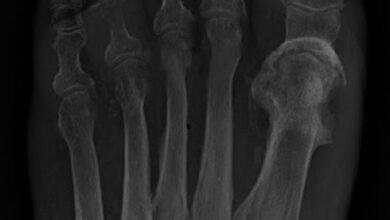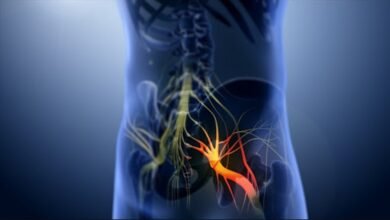
Multiple sclerosis is a chronic central nervous system disease.
The immune system attacks the protective layer around the nerve fibers.
Hence, it becomes difficult for nerve signals to pass from the central nervous system to the rest of the body.
In this article, we’ll talk about multiple sclerosis symptoms, causes, and treatment methods.
What is multiple sclerosis?
Nerves have an outer membrane surrounding them called myelin.
Myelin contains spaces with specific distances that help transmit nerve signals from the body of the nerve cell to the end of the nerve and transfer it further from one cell to another.
In multiple sclerosis, the immune system attacks the myelin sheath and causes inflammation and nerve damages that vary from temporary to permanent.
Consequently, this results in the deterioration of the nerve and the difficulty in transmitting electrical signals through it.
Symptoms vary in severity according to the location of the injury and the number of nerves affected.
They also vary according to the number of white blood cells involved in the inflammatory reaction.
Moreover, the nature of the disease cannot be controlled, but medications are used to control symptoms and their severity.
Multiple sclerosis causes
There is no specific cause to acquire the disease.
However, several factors increase the chances of developing it.
These factors are classified into; primary and secondary.
Primary factors
Those factors include;
The immune system
Multiple sclerosis is an autoimmune disease in which the immune system mistakenly attacks the body instead of attacking foreign bodies.
Scientific research has proven the presence of two types of immune cells that play an essential role in the emergence of multiple sclerosis; These cells are called B cells and T cells.
An unknown stimulus (probably a protein involved in myelin formation) activates the T cells.
Subsequently, the T cells travel to the central nervous system through the blood and secrete substances that cause inflammation.
When inflammation occurs, another type of T cell called Regulatory T cells helps reduce the spread of inflammation.
However, in the case of multiple sclerosis, the work of the Regulatory T cells stops.
Hence, this increases inflammation and destroys neighboring cells.
On the other hand, B cells are activated by; T cells called helper T cells.
The B cells also pass through the blood to the nervous system and secrete antibodies and proteins that destroy the nervous system.
The genes
You may be wondering, is sclerosis hereditary or not?
A genetic disease is one that an individual inherits from one of his parents.
In multiple sclerosis, though, the situation is different.
There is no specific gene that the individual inherits.
However, having a family history of the disease increases the chances of occurrence.
Moreover, for the disease to manifest, gene mutations have to occur in more than one gene.
These genetic mutations are determined by; other factors such as environmental factors and infection that increase the likelihood of its occurrence.
According to the National Multiple Sclerosis Society, 200 genes have been studied to discover their role in sclerosis.
They found that a large number of these genes indeed play a role in regulating the work of the immune system.
The environment
Some environmental factors that play an essential role in multiple sclerosis include;
- Vitamin D deficiency and lack of exposure to sunlight.
- Air pollution.
- Organic substances such as Benzene.
- Infection.
Vitamin D deficiency and lack of exposure to sunlight
An individual gets vitamin D from food and by exposure to sunlight to maintain a healthy immune system.
Epidemiologists stated that the incidence of sclerosis is lower in regions near the equator than in farther areas.
Air pollution and organic substances
Exposure to chemical fumes, radiation, and organic matter increases inflammation and oxidation in the body.
Especially when other factors are present; that increase the chances of acquiring the disease.
Infection
Common viral infections that increase the chances of infection include;
- Human Herpesvirus- 6.
- Varicella-zoster virus (VZV).
Secondary factors
Several factors increase the chances of developing sclerosis:
- Age: The chances of acquiring the disease increase between the ages of 20 to 40 years.
- Smoking.
- Obesity.
- Gender: Females are 2 to 3 times more likely to get multiple sclerosis than men.
Until today, there is no primary cause for sclerosis, but the chances increase significantly when these factors are present.
Symptoms of multiple sclerosis
Multiple sclerosis has varying symptoms according to the number and size of damaged nerves.
It affects the central nerves in the brain or spinal cord, as well as the optic nerve.
Symptoms include the following;
Fatigue
80% of people with multiple sclerosis suffer from fatigue, which affects the performance of daily functions.
Difficulty walking
A person may experience falls and difficulty moving due to several factors, including;
- Balance problems.
- Muscle weakness.
- Tingling in the extremities.
- Muscle stiffness.
Vision problems
Vision problems are the first symptoms that affect a patient with sclerosis and may affect one or both eyes.
The most common visual symptoms are:
- Double vision (Diplopia).
- Involuntary eye movements (Nystagmus).
- Blindness.
- Optic neuritis.
Speech problems
Stuttering (Dysarthria): It is a speech disorder where
the person has difficulty commencing speech, slowing down, and uttering unintelligible words.
Other symptoms of multiple sclerosis include;
- Difficulty with cognitive processes (memory, concentration, and attention).
- Constant shivering.
- Bladder problems.
- Difficulty swallowing and chewing.
From here, you may wonder, is there is a relationship between multiple sclerosis and pregnancy?
The relationship between multiple sclerosis and pregnancy
Sclerosis does not affect pregnancy, as studies have shown that a woman can become pregnant with no significant complications.
Moreover, the severity of the attacks can be controlled, especially in the second and third trimesters by, using steroid medicines.
Types of sclerosis
There are five main types of multiple sclerosis:
Clinically Isolated Syndrome
It is the pre-multiple sclerosis stage; symptoms last for 24 hours or less.
Relapsing-remitting multiple sclerosis
This type contains two stages of the disease.
The first is the relapse stage, where the symptoms worsen in severity.
The second is the remission stage, where the symptoms decrease in the severity or disappear.
Primary Progressive Disease
In this type, the patient experiences gradual worsening of symptoms.
Secondary Progressive Disease
It arises when the regressive type turns into the primary progressive type.
That is to say; The symptoms do not go away but continue to progress over time.
Benign Multiple Sclerosis
It represents 5 to 10% of cases of sclerosis.
The patient’s health does not deteriorate even after 15 years of diagnosis.
However, this type is difficult to diagnose, especially at the onset of the disease.

Multiple sclerosis diagnosis
The doctor diagnoses the disease using several methods, for example;
- Magnetic resonance (MRI).
- Optical coherence tomography (OCT).
- Lumbar puncture.
- Blood analysis.
- Visual Evoked Potential Test.
Multiple sclerosis treatment
Doctors use a wide range of methods to treat multiple sclerosis, for example;
Corticosteroids
They are used to reduce inflammation, including:
- Prednisone oral tablets.
- Prednisolone injected into a vein (Prednisolone).
Plasma separation
It involves; removing the blood from the body, purifying it of antibodies that attack the nervous system, and finally returning the clean blood to the body.
Disease-Modifying Therapies
These therapies reduce the speed of disease progression, for example;
- Beta Interferons.
- Glatiramer Acetate.
Treating symptoms of sclerosis
Symptoms include fatigue, muscle weakness, and difficulty moving.
Treatment methods include;
- Natural therapy.
- Using a muscle relaxant.
- Eating a healthy diet.
- Playing sports.
Finally, after learning about multiple sclerosis, it is crucial to visit the doctor if you feel any symptoms.
Early treatment; contributes to reducing the severity of symptoms and improves prognosis significantly.



